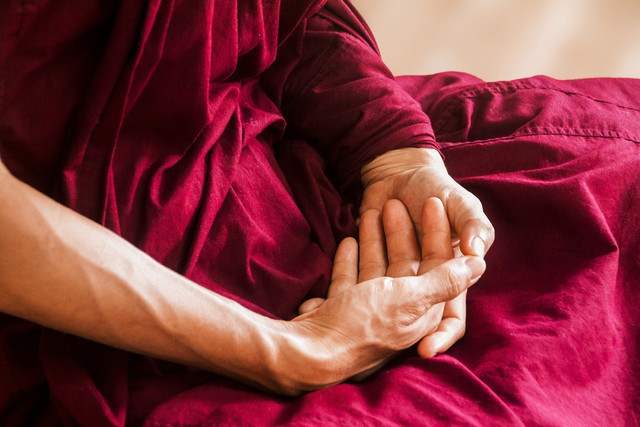
Yamas are the five ethical principles underlying traditional yoga teachings. They can help us develop a peaceful relationship with our fellow human beings and the environment.
The so-called Ashtanga Yoga is a traditional form of yoga that describes its practical philosophy of life as an eight-limbed path (ashta = eight, anga = limb). This is because yoga goes beyond the physical aspects and is to be seen as an attitude to life.
One of the eight limbs is the asana practice, the physical exercises that are the focus of Western culture. The first limb, however, are the so-called “Yamas” – as it is written in the “Yoga Sutras”, one of the oldest yoga texts from the 3rd century. The sutras were written in Sanskrit, an ancient Indian language. Accordingly, the Yamas are also named in that language.
The Yamas consist of five basic principles and can be understood as a moral code towards the environment. They form the basis for a peaceful atmosphere in which the practitioner can follow his teachings.
Regardless of whether you stand on the yoga mat every day or whether the physical exercises are not for you: The Yamas can also serve as a guideline for us in modern times to find a fair and peaceful way of dealing with our fellow human beings, animals, plants and all other parts of the environment.
We spoke to Julia Kounlavong, yoga teacher and founder of unwind your mind (ottonova’s Health X Partner): “The way we deal with others and ourselves has a huge impact. Integrating mindfulness into everyday life is really easy. And that’s often where the challenge lies. We’re used to everything being challenging and complex and we find it hard to get used to these little things. But the more often we consciously breathe, pause and think about what we’re thinking and how we judge, the more often we break the autopilot and consciously perceive what’s happening. And that’s exactly what it’s about!”
1. Yama: Ahimsa, non-violence

(Photo: CC0 / Pixabay / truthseeker08)
The term “Ahimsa” can be translated as non-violence or non-harming. According to the Yoga Sutras, if you embody Ahimsa, no hostility can flourish around you.
Violence here does not only refer to physical violence, but also to hurting others through words – for example, by insulting them. But even thoughts are included here: those who truly live Ahimsa stop judging or slandering other people.
This also includes how you treat yourself: We often harm ourselves by having thoughts like “I’m too bad for that anyway” or “I’m not worthy of…”. Instead, we want to learn to love ourselves and treat ourselves better with self-care.
Ahimsa in modern life:
If you want to integrate the Yamas into your life, self-observation is the basic requirement.
- Become aware of how you behave towards other living beings and towards yourself.
- Be aware of when and how you use violence of any kind. Simply being mindful of this will help you develop a more peaceful being.
- One possible step could be to eat less meat and thus spare countless animals from physical violence.
- But any form of non-violence towards our planet is also Ahimsa, for example climate protection.
- Non-violent communication is just as important. You can learn this by practicing active listening and increasing your emotional intelligence.
The aim of Ahimsa is to ensure peace on all levels and to develop compassion for our fellow human beings and the environment. The Dalai Lama also emphasizes in an interview how important more love from the heart is in today’s times.
2. Yama: Satya, truthfulness

(Photo: CC0 / Pixabay / pixel2013)
The principle of Satya is also the foundation of many social and religious teachings: You shall not lie. In yoga, however, it is recognized that truth on a human level is always relative and subjective.
This Yama is about being and speaking authentically, expressing your inner self and your own truth, and not pretending to be anything to yourself or others.
Satya in modern life:
To live Satya consciously, you must also observe yourself, your words and thoughts closely.
- Be aware of this whenever you do not express the truth.
- Also pay attention to when you are deceiving yourself – for example, when you allow an exception to your established rules.
-
Leave your comfort zone and get in direct, honest contact with yourself.
When dealing with other people, it is important to tell the truth. But always keep in mind the principle of ahimsa: empathize with the other person and find words that are honest but also kind. Express your thoughts and feelings without accusing or hurting the other person. In some cases, this may mean remaining silent instead of speaking.
3. Yama: Asteya, non-stealing and renunciation of greed

(Photo: CC0 / Pixabay / Free Photos)
Asteya is the third of the Yamas in the Yoga Sutra and can be literally translated as “non-stealing.” However, this principle goes far beyond material possessions.
Those who practice Asteya not only rob others of their material possessions, but also do not take credit for other people’s ideas, such as selling someone else’s idea as their own. It is also about not abusing the trust of others or robbing them of their time or freedom. Ultimately, Asteya aims to renounce greed and desire and to find contentment in what one already has.
Asteya in modern life:
It should be clear that we are not allowed to appropriate other people’s belongings.
- However, watch out for any desire to enrich yourself through other people’s fame and ideas. Ultimately, any form of desire is a contradiction to Asteya.
- We can also extend this Yama to the environment and ask ourselves: To what extent are we stealing from our planet through deforestation? To what extent are we robbing animals of their freedom and their lives through overfishing in the oceans or through factory farming?
By consuming less and more consciously, you can say no to greed and act with respect for your planet. Be aware of how often you eat meat or fish.
4. Yama: Brahmacharya, self-control

(Photo: CC0 / Pixabay / RobertCheaib)
The fourth Yama of the Yoga Sutras is Brahmacharya, which can be translated figuratively as “moving towards the essential” or “acting in the consciousness of the universal soul”. This is about moderation of the senses and passions.
Originally the focus was on celibacy, but Brahmacharya can be understood as any form of abstinence or moderation. It is about avoiding extremes and not allowing oneself to be controlled by one’s desires.
Bramacharya in modern life:
There are many forms of asceticism that can contribute to a happier life.
- This could include, for example, a smartphone diet, living a minimalist lifestyle or giving up an addiction (tobacco, chocolate, television, etc.).
- You don’t have to give up everything completely, but you should aim for moderation in your behavior. For example, use your bike more often or walk instead of taking the car for short trips or to go shopping.
- Train your mental strength and get rid of bad habits.
5. Yama: Aparigraha, non-hoarding

(Photo: CC0 / Pixabay / FranckinJapan)
Aparigraha can be translated literally as “non-hoarding” or “non-collecting” and is closely related to Asteya, the principle of non-stealing. It is about realizing how little is needed for a contented life and about renouncing excessive possessions and consumption.
Aparigraha in modern life:
What was once called Aparigraha in ancient India is the principle of minimalism in modern Western society.
- In times of excess and mass consumption, simplicity is being rediscovered. More and more people are realizing that more possessions do not make them happier – and are freeing themselves of unnecessary belongings.
- There are many ways to live a minimalist lifestyle and use different methods to free your home, your mind and your life of unnecessary clutter. For example, the Swedish method of “Death Cleaning” or Marie Kondo’s method of “Magic Cleaning” can help you.
- The zero-waste principle can also become part of modern Aparigraha. You can help prevent more waste from being created and accumulated in the world.
Yamas – where should I start?
As you can see, the Yamas are not an outdated theoretical teaching, but offer a lot of potential for today’s life in modern societies. If we all lived according to these five principles of traditional yoga, pollution, overexploitation, injury and violence among people, animals and plants would be a thing of the past.
We are now a long way from this utopia, but we should not let this discourage us: every step in the right direction is important. But don’t put yourself under pressure and don’t try to turn your whole life around overnight. Take it step by step and appreciate the small successes along the way.
Julia Kounlavong recommends a gentle introduction: “Pay attention to your breathing, do a short body scan, cook and eat consciously and mindfully without distraction, use brushing your teeth and showering to NOT think. Use your senses to constantly check in with yourself and see what happens, for example, after three weeks of continuous practice.”
By the way: There is also a yoga code that can help you especially in your private life – the Niyamas.
Read more on Techzle\.com:
- Climate refugees: When climate change becomes a reason for flight
- Learning meditation: tips for beginners
- Think positively: How to learn and get rid of negative thoughts
** marked with ** or orange underlined Links to sources are sometimes affiliate links: If you buy here, you are actively supporting Techzle\.com, because we then receive a small part of the sales proceeds. More information.